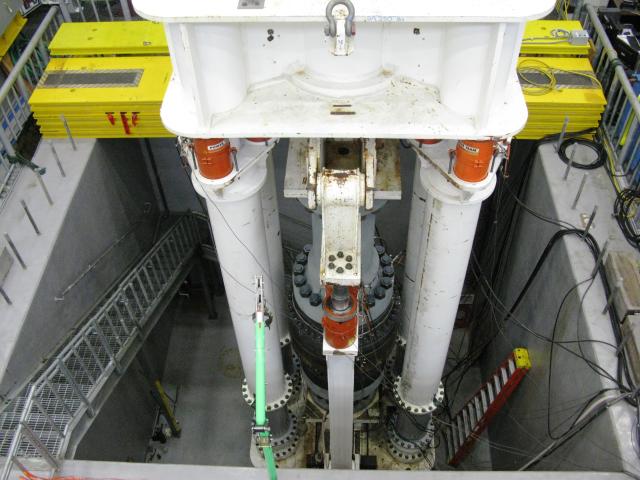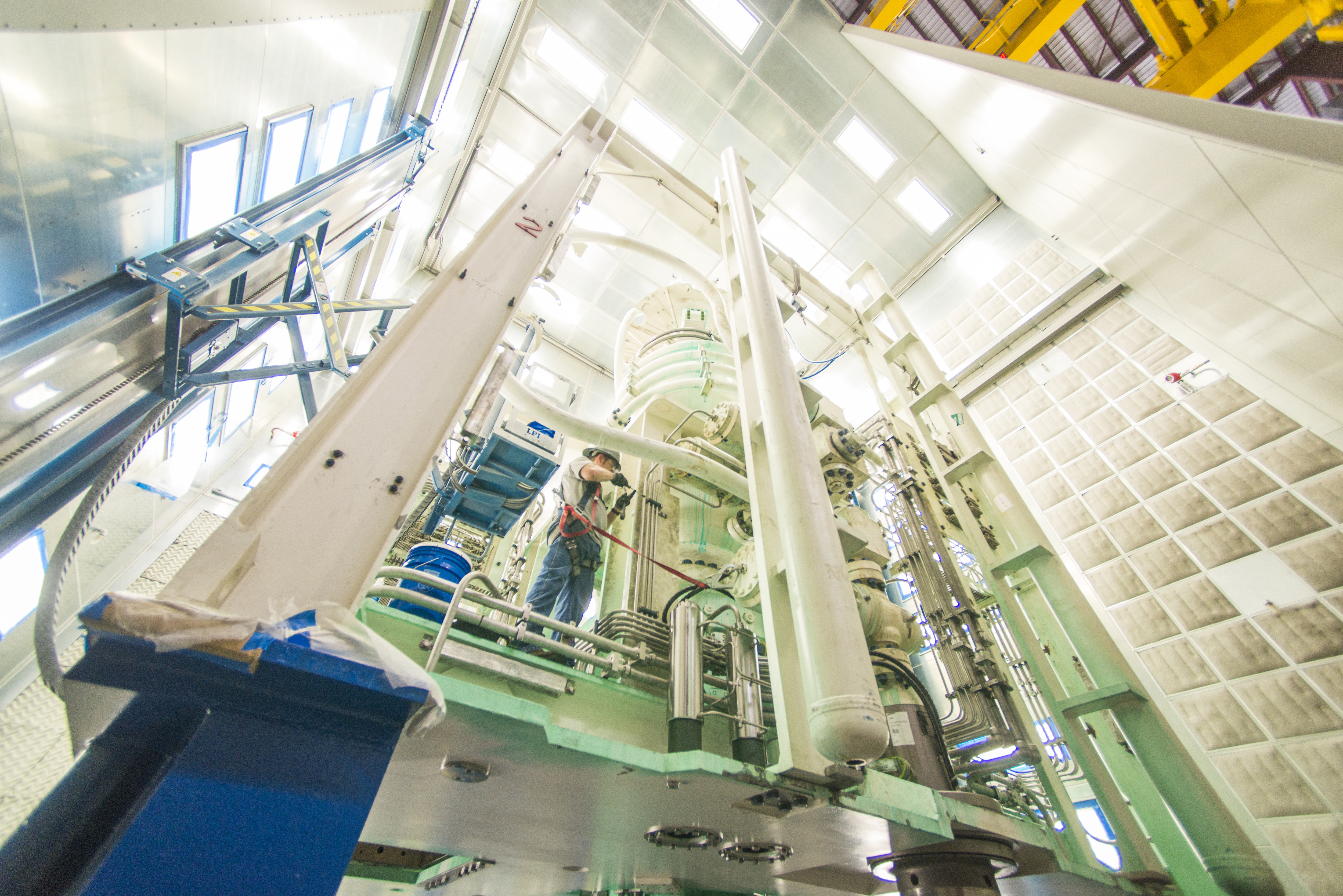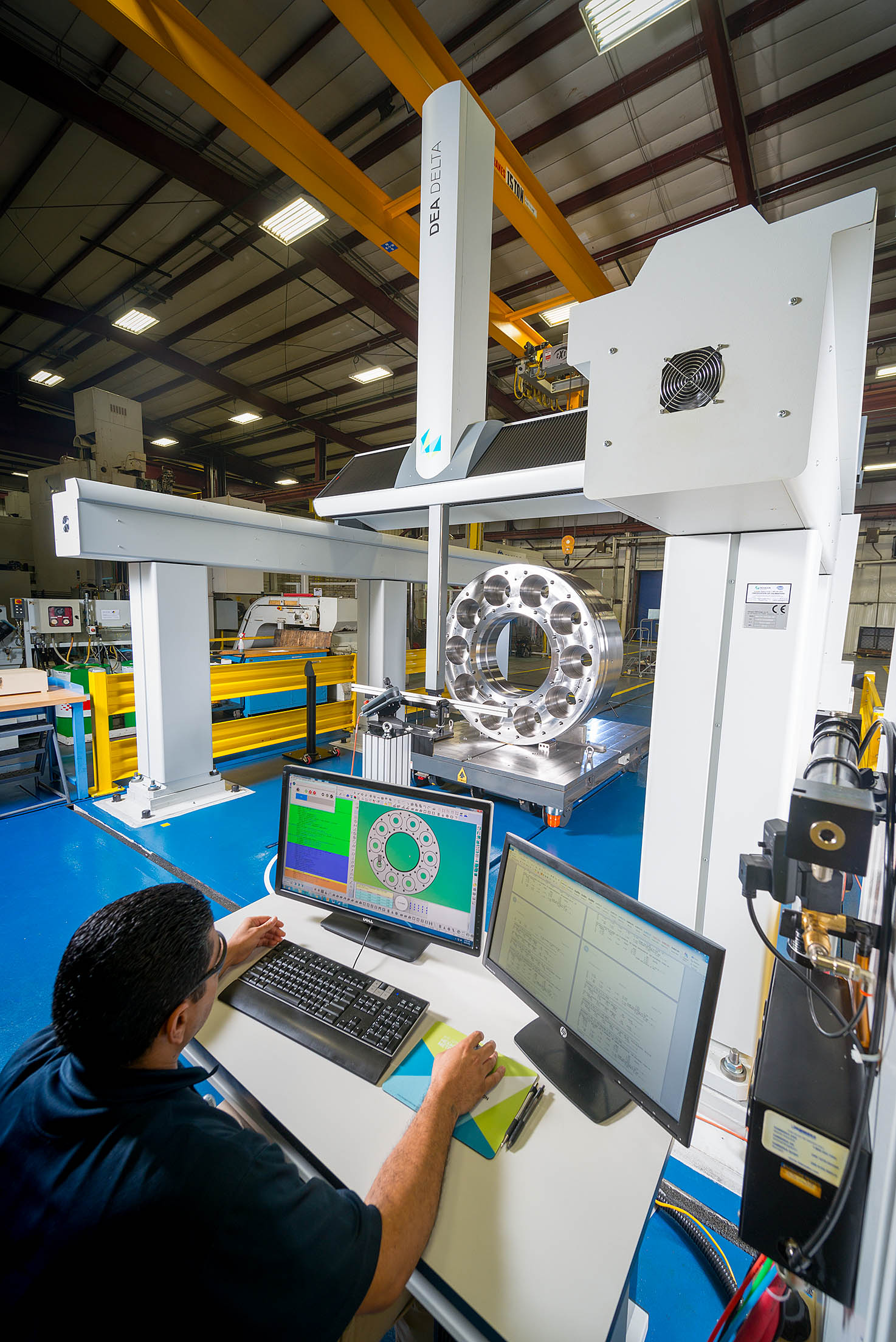
A 20K wellhead connector undergoes bending load testing. (Source: GE Oil & Gas)
The economic promise of vast offshore hydrocarbon reservoirs, currently out of reach due to extreme formation pressures and temperatures, continues to motivate operators and contractors to evaluate the technology portfolio needed to safely harness these resources. GE Oil & Gas has embarked upon a comprehensive technology mission with its customers to develop enabling drilling equipment required to handle the extreme pressures and temperatures. Lower Tertiary fields such as the Shenandoah, Kaskida and Tiber in the Gulf of Mexico are a few examples where pressure and temperatures might be beyond the 15,000-psi and 121-C (250-F) ratings of currently available equipment. GE and its customers are collaboratively designing, building and testing the equipment needed to safely drill wells with pressures of 20,000 psi (20K) and temperatures of 177 C (350 F) and a riser with a 4.5-million-pound flange capacity for global deployment.
Regulatory requirements, design considerations
Designing, building, testing and maintaining equipment that is fully compliant with regulatory bodies is a paramount goal, yet fully balloted regulations governing 20K systems are not available. In lieu of prescriptive industry regulatory guidance, GE’s drilling project initially used both the American Society of Mechanical Engineers’ BPVC Section VIII Division 2 and Division 3 design paths to design each component along with following the guidelines in American Petroleum Institute (API) 17TR8. This led to a conservative approach that might yield an increased component weight. Recent industry publications have suggested that the more conservative Division 2 design path might be the preferred option for HP/HT subsea drilling equipment, which aligns with GE’s design approach.

Multiphase system approach
This highly complex project necessitates the application of funding and resources on key equipment at staggered intervals. The BOP and wellhead connector were the first systems for HP/HT development. The GE 20K wellhead connector has been fully designed, built and qualified in preparation for deployment as part of a capping stack. The system, including GE’s new 18¾-in. 20K flange, has completed a 30,000-psi hydrotest, exceeded the cycle counts for the API 16A Sealing and Locking Mechanism tests and performed combined pressure/tension/ bending load tests. Additionally, the flange and gasket have completed a PR2 test up to 20K from -18 C to 177 C (0 F to 350 F) per API 6A and pressure cycling per API 17D.
The riser and associated support equipment design is the next large 20K drilling system slated for completion. An extraordinary amount of finite element analysis has been conducted to date as well as a global riser analysis to validate the myriad design options such as auxiliary line load sharing, 27-m (90-ft) joint lengths and 177-C temperature ratings for the choke and kill lines. The riser connection configuration will initially be MR-6J-SE, which uses six retractable latching dogs to positively connect corresponding riser joints. The “J” is associated with the API 16R tension class of 4.5 million pounds, which also could apply to a bolted flange configuration if desired by a customer.

BOP qualification has progressed well. The development of a casing shear ram, Hydril Variable Ram, blind shear ram and pipe rams using 22-in. and 28.5-in. operators is well underway. Recent shear testing of a complex sample using a blind shear ram was performed successfully followed by a high-pressure seal at 20K for 35 minutes. GE is conducting testing above and beyond the API requirements to prove reliability for critical HP/HT equipment.
Other 20K developments
As part of the overall 20K system GE also has designed, developed and qualified a 20K choke and kill (C&K) connector and qualified a 20K C&K valve. GE will supply its next-generation SeaPrime I and SeaONYX controls to meet the reliability and availability demands of 20K systems.
The road to developing and providing a complete suite of 20K-ready drilling products is not without its pivots. Commercial realities arising from lower commodity prices as well as technical challenges have impacted the development pace, yet these have not lessened the commitment for success. All indications are that the industry is committed to the development of 20K drilling systems to support the development of challenging reservoir portfolios.
Recommended Reading
E&P Highlights: Jan. 21, 2025
2025-01-21 - Here’s a roundup of the latest E&P headlines, with Flowserve getting a contract from ADNOC and a couple of offshore oil and gas discoveries.
Inside Ineos’ US E&P Business Plan: Buy, Build, Buy
2025-01-27 - The E&P chief of U.K.’s Ineos says its oily Eagle Ford Shale acquisition in 2023 has been a profitable platform entry for its new U.S. upstream business unit. And it wants more.
New Jersey’s HYLAN Premiers Gas, Pipeline Division
2025-03-05 - HYLAN’s gas and pipeline division will offer services such as maintenance, construction, horizontal drilling and hydrostatic testing for operations across the Lower 48
Darbonne: The Power Grid Stuck in Gridlock
2025-01-05 - Greater power demand is coming but, while there isn’t enough power generation to answer the call, the transmission isn’t there either, industry members and analysts report.
E&P Highlights: Jan. 6, 2025
2025-01-06 - Here’s a roundup of the latest E&P headlines, including company resignations and promotions and the acquisition of an oilfield service and supply company.
Comments
Add new comment
This conversation is moderated according to Hart Energy community rules. Please read the rules before joining the discussion. If you’re experiencing any technical problems, please contact our customer care team.





